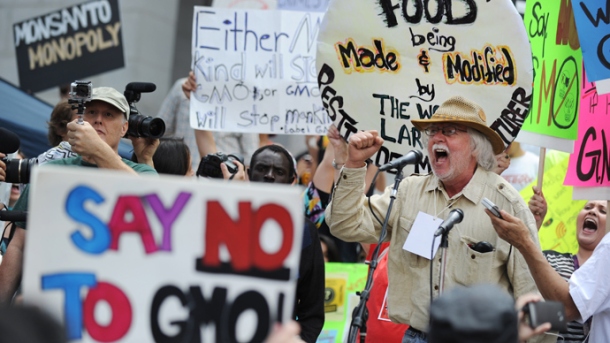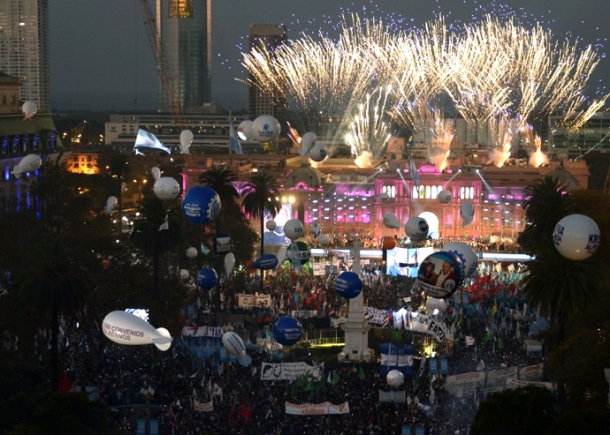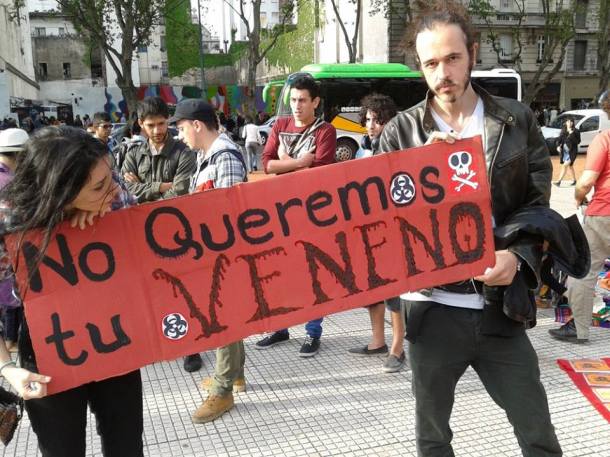The second worldwide March Against Monsanto protest took place on October 12, 2013 to coincide with World Food Day. According to the group Occupy Monsanto over 400 marches were held worldwide.
March Against Monsanto was founded by Tami Canal in response to the failure of California Proposition 37 on November 6, 2012, a ballot initiative that would have required labeling food products made from genetically modified organisms (GMOs).
The first worldwide demonstrations took place on May 25, 2013. On that day I was a member of a group of around 200 that gathered at Plaza San Martin in downtown Buenos Aires. Plaza San Martin is less than a five minute walk away from Monsanto HQ Argentina and after occupying the plaza for most of the day, at dusk the crowd moved to the offices. They had been boarded up in anticipation of the event so protestors got busy with spray cans creating some colorful graffiti. After chanting outside the empty office building for around 30 minutes the crowd began their march towards Plaza de Mayo; Buenos Aires’ main square and home to the Presidential Palace; the Casa Rosada.
Unfortunately, known to all in attendance before the event, May 25 is of great importance in Argentina as it marks the annual celebration of the May Revolution. This year’s celebration was big, with performances by international bands and a speech by President Cristina Fernández de Kirchner. When the March Against Monsanto group got within five city blocks of Plaza de Mayo it began to merge with the May 25 congregation, made up of thousands of people. Our voices were drowned out by the fireworks and general buzz of the masses.
Once we got a little closer to the square an air of animosity could be felt as pro-government supporters became aware of our presence. At one moment a small group of pro-government men stood in front of our group wielding discarded bamboo sticks that had been used as poles for the demonstration’s political flags. Some of the Monsanto marchers reeled back at the sight of the men blocking our way but the men themselves seemed to blend into the crowd and disappear. It felt as if they were ready to strike but had been told that we were not anti-government and did not pose a threat. After the excitement I decided to call it a day.
The May 25 March Against Monsanto was overshadowed by The May Revolution celebrations
Hopes were high for a bigger turnout this time but yet again circumstances did not favor the event.
Firstly, October 14 marks the ‘Day of respect for cultural diversity’ in Argentina resulting in a three-day long weekend. Many residents leave the city on long weekends and the exodus must have affected the turn-out. Secondly, October 12 also marks Columbus Day and March Against Monsanto had to compete with other groups representing indigenous peoples and culture. Sadly, there were less people at the October 12 protest than there had been at the May 25 one.
Unlike May 25 the second event took place outside the Argentine National Congress Palace; an open space at the end of the city’s main avenue, Avenida de Mayo. When I arrived there were around 100 people in attendance, a small folk band was playing and activists were preparing speeches.
I was lucky enough to get the opportunity to speak to a few of the participants.
Luis, 31, from Bilbao, Spain, was attending with a group of friends. Having lived in Argentina for several years Luis has attended political demonstrations against the government during his time in the country but this was his first demonstration against the bio-technology industry. Well informed, Luis, told me about how different European countries dealt with GMO’s and the protection of domestic crops. He was conscience of the food he ate and expressed his concerns with the health risks posed by GMO’s.
Maria Jose, 46, from the countryside between Cordoba and Buenos Aires and has been fighting against Monsanto since 1992. Monsanto is a part of what Maria Jose describes as the destructive model. She is a member of G.R.R. – Grupo de Reflexion Rural – an organization for dialogue and multidisciplinary debate on the impacts of Global Capitalism. Maria Jose is concerned with the soya and corn industries in Argentina which are major contributors to deforestation.
Ayelen, 22, from Villa Gessell is a university student studying social communication. A member of Weychan, an organization that supports Argentine indigenous peoples, Ayelen moved to the city to study but also to participate in political movements. Ayelen attends any demonstration against the ‘extractive model’; where multinationals extract natural resources from developing nations.
Outside the Argentine National Congress Palace, October 12
Another university student I spoke to was Evelyn from Lanus University, Buenos Aires. As a member of her social sciences faculty she discovered that her public university was being funded by Minera Alumbrera; a large mining company, which motivated her to become an activist. Every year the university faculty organizes excursions to La Rioja province to raise awareness concerning the mining industry. In the past the organization has had problems with the police on such excursions as the mining industry does not approve of their actions. Monsanto is just another fight against corporate greed. Her organization, Vision Sostenible, conducts research projects, promotes alternative energy methods and pushes for new environmental laws in Argentina.
The final person I spoke to was Emi, 23, from Buenos Aires. Emi attended the event to support the fight against authority and regularly attends all such events. He describes Monsanto as ‘people who have money and think they can interfere in other people’s lives’. Whilst speaking Emi presents his make-shift stall selling fanzines, independent literature, with libertarian and anarchistic ideology. He is opposed to the bio-technology industry and believes that everyone needs to take care of the world and protect the future. Emi is a supporter of The Sala Alberdi Movement, a community of squatters who have occupied and self-manage the Sala Alberdi building in Buenos Aires.
After finishing my interviews I looked around in the hope that a march would soon begin. Sadly, nothing seemed to be happening apart from a punk band performing some very loud and energetic songs. As my friends and I decided to leave another march was just beginning from another part of the avenue. It was an indigenous march with participants waving colorful Incan flags and playing instruments. I couldn’t help feel that the March Against Monsanto protest could have been a little better organized, much like May 25, the event seemed to lack direction. I do not know if the event eventually began a march of its own of joined the back of the indigenous one.
In conclusion, the Buenos Aires’ March Against Monsanto was small and a little poorly organized but did attract some passionate and serious activists of all ages. Considering that Buenos Aires has a population of nearly 13 million, it could develop into a real example in the fight against Monsanto in South America.
Originally posted on The Pianosa Chronicle




No comments:
Post a Comment